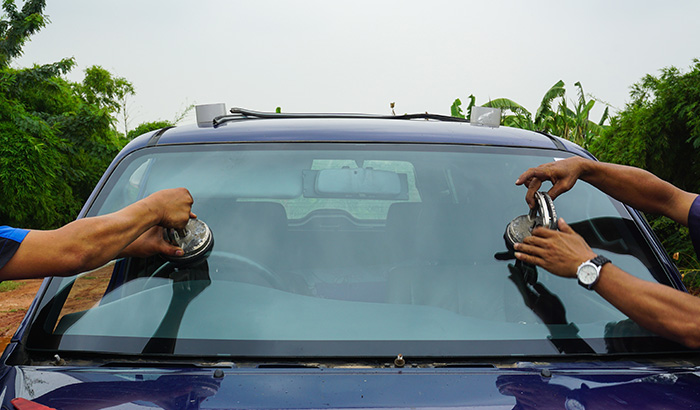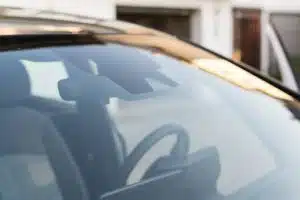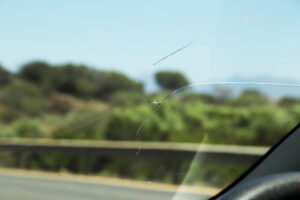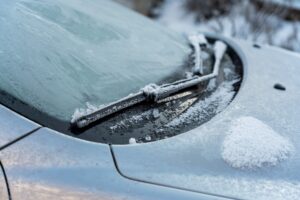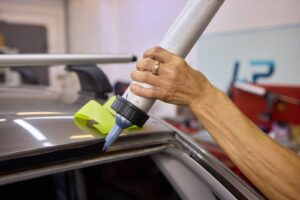Imagine you’re driving, and suddenly your windshield cracks. This may be a minor inconvenience, but it’s also a critical safety issue. The windshield replacement process is a meticulous one that demands precision, expertise, and the right materials.
In this article, we’ll take an in-depth journey through each stage of the windshield replacement process, providing you with a detailed view of what unfolds from the moment you spot a crack to when you’re confidently driving again with a new, securely installed windshield.
Understanding windshield replacement
The critical role of your windshield
Safety barrier:
- Supporting the Car’s Roof: The windshield contributes significantly to the structural stability of your vehicle, particularly in rollover accidents.
- It supports the car’s roof, prevents it from collapsing on passengers, and maintains the vehicle’s structural integrity.
- Aiding in Airbag Deployment: In many cars, the windshield is a backstop for the passenger-side airbag. If the windshield isn’t properly installed or is compromised, the airbag may not deploy correctly, putting passengers at risk.
Protecting passengers:
- Beyond a barrier from wind and debris, the windshield protects occupants from being ejected during a collision.
- It comprises laminated glass, which includes two layers of glass with a plastic layer sandwiched between them, holding the pieces together upon impact.
Visual clarity:
- Essential for Safe Driving: Clear visibility is paramount for safe driving. A clean and undamaged windshield provides the driver with an unobstructed view of the road, pedestrians, and other vehicles, which is crucial for making informed and safe driving decisions.
- Impact of Impairments: Even minor chips or cracks may grow and spread, leading to significant visibility issues. Impairments distort and obstruct the driver’s view, leading to misjudgment of road conditions, distances, and potential hazards.
Recognizing the need for replacement
Types of windshield damage:
- Chips: Usually caused by small rocks or debris hitting the windshield. Chips are minor damage but could quickly become larger cracks if not addressed.
- Cracks range from small lines to large spiderwebs spreading across the windshield. Temperature changes, road bumps, and pressure all cause cracks to grow over time.
- Shatters: Even though designers make modern windshields to hold together when broken, a severe impact may still cause extensive damage, making them unsafe and requiring immediate replacement.
Assessing the damage:
- When to Repair: Minor chips and small cracks, typically those less than the size of a dollar bill, can often be repaired. This process involves injecting a resin into the damaged area to restore integrity and clarity.
- When to Replace: Larger cracks, particularly those that extend to the edges of the windshield, multiple areas of damage, or anything that impedes the driver’s line of sight, typically require a full replacement. Additionally, if the inner layer of the glass is damaged, or the damage is right in the driver’s view, replacement is the safest option.
- Professional Assessment: It’s crucial to have any windshield damage assessed by a professional. They determine the best course of action based on the size, type, and location of the damage, ensuring your safety and the vehicle’s integrity.
Choosing a qualified technician:
- Certifications and Experience: Choosing a technician with the right certifications and a proven track record is important.
- Questions to Ask: Provide a checklist of questions you should ask your technician to ensure they’re the right fit for the job.
The replacement process detailed
Step 1: Removing the damaged windshield
- Tools Used: Detailed description of the tools used in the process, like cold knives, wire cutters, or automated removal tools.
- Protecting the Vehicle: Discuss how technicians protect the car’s interior and body from damage during removal.
Step 2: Preparing the frame
- Cleaning the Area: Removing old adhesive and debris from the pinch weld is important.
- Inspecting for Damage: How technicians assess and treat rust or corrosion to prevent future issues.
Step 3: Applying the adhesive
- Types of Adhesive: Deep dive into the urethane adhesives used and their curing times.
- Application Technique: Discuss the precision required in applying the adhesive to ensure a perfect seal.
Step 4: Installing the new windshield
- Alignment and Placement: These are the crucial steps of aligning the windshield correctly and placing it onto the adhesive.
- Setting and Sealing: How technicians ensure the windshield is perfectly set and sealed.
Step 5: Curing and drying time
- Waiting Period: Explain why the car needs to sit for a certain period, how long it typically is, and what factors might affect it.
Step 6: Quality checks and cleanup
- Inspection: Detail the final checks for leaks, alignment, and functionality.
- Cleaning Up: How technicians clean the area and the windshield for a pristine finish.
Post-replacement care
First 24 hours:
- Driving Restrictions: Experts generally advise waiting at least one hour before driving the vehicle after installing a new windshield. This time allows the adhesive to cure enough to hold the windshield securely in place during driving. However, the full cure time can extend up to 24 hours or more, depending on the type of adhesive used and environmental conditions.
- Window Positioning: Leave a window slightly open about an inch to prevent pressure build-up inside the vehicle that could compromise the new seal, especially on warmer or sunnier days.
- Avoiding Car Washes: Steer clear of high-pressure car washes and power washers. The force of the water may unsettle the seal and adhesive before they have fully set.
Gentle use:
- Gently close doors and avoid rough roads or jarring movements that might shift the windshield before the adhesive fully cures.
Long-term maintenance
Regular inspections:
- Check for Leaks: Regularly inspect the windshield’s edges for signs of moisture or air leaks. Even small leaks may lead to significant problems, like water damage inside your vehicle or a windshield that becomes loose over time.
- Monitor for Damage: Look for new chips, cracks, or other damage. Early detection is key to addressing issues before they require another full replacement.
- Seal Integrity: Occasionally check the seal around the windshield to ensure it remains intact. Over time, the seal degrades due to exposure to the elements, so it’s important to catch any seal issues early.
Cleaning tips:
- Appropriate Cleaners: Use cleaners specifically designed for automotive glass to avoid damaging the tint or causing streaks. Avoid ammonia-based cleaners, especially if your car has tinted windows, as they may break down the tint over time.
- Soft Materials: Use a microfiber or soft cotton cloth to clean the windshield. Harsher materials cause scratches, especially if there’s dirt or sand on the windshield.
- Regular Washing: Regular cleaning maintains visibility and allows you to inspect the windshield closely for any new issues.
- Wiper Blade Care: Regularly clean and replace your wiper blades to prevent scratches and streaks on your new windshield. Damaged or old wiper blades degrade the glass surface over time.
Importance of professional service
Expertise and reliability:
- Trained Professionals: Safety and Precision: Skilled technicians bring a level of precision to the installation process that is vital for your safety. A properly installed windshield contributes to the vehicle’s structural integrity, especially in a rollover or collision.
- Professionals understand the science behind placement, adhesion, and curing and ensure they perform everything correctly.
- Up-to-date Knowledge: Technicians continually update their training to keep up with the latest advancements in windshield technology and installation techniques. This includes understanding how to handle various features integrated into windshields, such as Advanced Driver Assistance Systems (ADAS) sensors and heads-up displays.
- Problem-Solving Skills: Experienced professionals anticipate and address issues that might not even cross a layperson’s mind. From dealing with unexpected rust or damage on the vehicle’s frame to managing peculiarities of specific car models, their expertise is invaluable.
Reliability of service:
- Consistent Quality: Professional services have standards and procedures in place to ensure every installation meets a high-quality benchmark. They use the right tools and materials for each job, ensuring the windshield fits perfectly and the bond is strong and lasting.
- Accountability: Reputable services stand behind their work. If something goes wrong, they will address it promptly. This accountability is part of what you pay for with professional service.
- Leak-Free Installation: Leaks are among the most common issues with DIY or subpar windshield installations. Professionals ensure that the seal and windshield are airtight, protecting you from leaks that lead to water damage, mold, or wind noise.
Warranty and peace of mind
Understanding warranty options:
- Coverage Details: Many professional windshield replacement services offer warranties that cover the glass and the installation. These warranties protect against leaks, wind noises, and material defects. Understanding what coverage lasts and how long it extends may save you money and prevent headaches down the road.
- Importance of Warranty: A warranty provides a safety net in case of issues and signifies the service provider’s confidence in their work. It’s a promise of quality and durability from the installer.
The value of peace of mind:
- Confidence in Safety: Knowing that trained professionals have replaced your windshield allows you to drive with confidence. You’ll trust that the windshield will perform as expected in protecting you and your passengers.
- Stress-Free Experience: Delegating this critical task to professionals frees you from the worry and stress of attempting it yourself. You don’t have to second-guess whether you’ve done everything right or worry about making costly mistakes.
- Time Savings: Professionals complete the job quickly due to their expertise and experience. This efficiency means your car will be ready to go sooner, and you’ll return to your daily life with minimal disruption.
Replacing your windshield involves much more than simply swapping out a piece of glass; it’s a critical procedure that ensures your vehicle remains a safe, secure haven capable of protecting you and your passengers on every journey. Understanding the detailed process behind windshield replacement gives you the knowledge and assurance to make informed decisions when selecting a technician and service.
This isn’t merely a maintenance task; it’s an investment in your vehicle’s integrity and safety. A properly installed windshield offers a clear, unobstructed view of the road ahead. It is a fundamental component of your vehicle’s safety system, contributing to your car’s structural strength and ensuring that airbags deploy correctly during an accident.
So, as you navigate the roads and life’s unexpected turns, remember the pivotal role of your windshield. Trusting professionals to replace it does more than restore a piece of your car; it renews your sense of security and comfort, guaranteeing that every journey, whether a daily commute or a long adventure, is as safe as can be.
DEPEND ON UTAH MOBILE AUTO GLASS FOR PREMIER MOBILE WINDSHIELD REPLACEMENT SERVICES
When you need a reliable and skilled mobile windshield replacement service, turn to Utah Mobile Auto Glass. We stand ready and committed to serving you.
Our team, boasting years of experience, is dedicated to delivering top-tier service in the industry, all with a friendly demeanor. Our outstanding service ensures our customers return to us time and again.
Utah Mobile Auto Glass is known for its adaptability, approachability, and straightforward interactions. No matter the size of your need, from a minor chip fix to a complete replacement of all your vehicle’s windows, we’ve got you covered.
Concerned about navigating through insurance?
Let us ease your worries. We’ll talk to your insurance company to see if you qualify for complimentary or reduced-cost services. Additionally, we provide free and convenient mobile service to all customers within a 25-mile radius of our Sandy base. This means quality assistance is a call away if you’re located in Lehi, Bountiful, Salt Lake City, or any surrounding area.
Eager to learn more? Reach out to us today to discover how we can assist you in getting back on the road safely and efficiently!
toto slot

